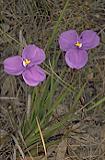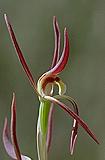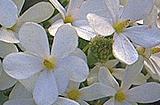
Banksia aemula (59k)

Banksia robur (43k)

Epacris pulchella (44k)

Epacris obtusifolia (41k)

Phebalium woombye (33k)

Patersonia sericea (35k)

Lyperanthus suaveolens (13k)

Ricinocarpos pinifolius (33k)

Boronia falcifolia (38k)

Melaleuca nodosa (38k)

Melaleuca thymifolia (36k)

Dillwynia glaberrima (28k)

Acacia baueri (21k)
|
|
I was asked to show our Wallum flowers to an Australia-wide audience, to emphasise both their dainty beauty and their sad fate.
On two hurried trips to the Sunshine Coast beforehand to check the Coolum/Peregian/Marcus Beach wallum areas, I found more destruction and damage than wildflowers for a TV programme. As the very dry weather wasn't helping either, it was quite depressing. Early August also wasn't the best flowering time, but I had to go along with the ABC's plans. Many phone calls between me and the lady in Tasmania (to sort out details and needs) and the day arrived.
We all met at 9.30 a.m. - Colin, me, cameraman and soundman, and the day's director, Darryl from Tasmania. Now I had been instructed to "show Colin the pretty flowers and play down the bad things", so it came as a big surprise to have Darryl lean towards the environmental things (all the recent development at Coolum Beach gave him a nasty shock).
First stop was to the west of the Maroochy Airport, Portion 878, which hopefully will some day become an Environmental Reserve. There was a lot of degradation from the adjoining industrial estate, but also some red Callistemon pachyphyllus, lots of Banksia robur with a few good flowers, pea-flowered Pultenaea myrtoides, a scattering of Epacris pulchella and E.obtusifolia, and their relation, Sprengelia sprengelioides - not a vast array really. But Darryl was pleased with the general sweep of the vegetation to distant Melaleuca quinquenervia. It was real Wallum and, to cap it off, one White-cheeked Honeyeater "posed" for us. These lovely birds rarely sit still for more than a few seconds, but this one stayed long enough to be captured on film.
Then to the shrinking remnant of Vanilla Lily field south of the original Surfair Hotel. Now three blocks of units with another being built at the time, this tourist "strip" is replacing the very last remnant of true wet flowering Wallum on the Sunshine Coast.
Here we were held up by someone else doing a spot with Channel 7; so we moved on to Coolum for morning tea and to discuss just where we could get the best "overview" of the Coast and its vegetation.
My earlier investigations had shown that the only option was the top of Emu Mountain, just to the north. Marvellous views from there! But was there enough time to climb up there, as well as do the necessary camera work? Darryl decided to give it a go, so it was the next stop on this unusual "ramble" where a rather "conservationist" interview was done.
Not a lot of flowers were filmed (I saw many more than the Phebalium woombye featured). Bossiaea ensata (with flattened stem and leaf) was plentiful with its red-marked yellow pea flowers, lots of white Burchardia umbellata, Patersonia sericea, Acacia hubbardiana and A.juncifolia, Comesperma hispidulum, everywhere Leptospermum microcarpum (grows prostrate here because of the wind), tiny yellow Hibbertia spp., Mirbelia rubiifolia.
At the summit, surviving the many feet and wheels assaulting them, were little Boronia polygalifolia in flower, yellow daisy-like Rutidosis murchisonii (also in the road drain at the start of the walk), Hardenbergia violacea, stunted Dodonaea viscosa var.cuneata, hairy grey-leaved Hibbertia linearis and others amongst the Kangaroo Grass clumps and other vegetation. Hiding under a windblown Casuarina emuina was a remembered plant of Boronla rosmarinifolia. But the crew had what they wanted, the "chat" and the views, and there wasn't time to dally over more flowers. However, the ground orchid, Lyperanthus suaveolens, caught their attention and place on the segment.
Off to lunch at Peregian Beach before going after the only accessible Banksia aemula flowers I was able to find, just outside the National Park at northern Marcus Beach. I am sure it put on a special show just for us, and an obliging Ricinocarpos pinifolius (Wedding Bush) was still in full bloom nearby.
By now the day was running out and I began to worry whether the light at the wildflower field would be enough to do justice to the flowers. With about an hour's daylight remaining, we worked in the wildflower field near Surfair. the cameraman getting general views, then filming Colin and me doing our little "show and tell" act.
No, there weren't enough flowers really. I was very disappointed that it couldn't have been done three weeks later when I collected many, many more flowers for the Coolum Wildflower Show. But we had Boronia falcifolia (couldn't do a Wallum show without that one), Epacris obtusifolia and E.pulchella, some yellow pea Dillwynia floribunda, fluffy-petalled Leucopogon virgatum (one of my favourites) and some Sowerbaea juncea (Vanilla Lily). A very tiny Wallum lesson for Colin, who was a fantastic "co-star", totally minus ego.
This diminishing wildflower remnant at Marcoola also boasts the following: Burchardia umbellata, Pultenaea paleacea, Dillwynia glaberrima, Viminaria juncea, another Leucopogon sp., Melaleuca nodosa and M.thymifolia, Leptospermum semibaccatum, Stackhousia viminea, red Callistemon pachyphyllus, Banksia oblongifolia and B.robur, Strangea linearis, a prostrate Persoonia sp. (leaves similar to P.virgata), Goodenia stelligera, Drosera spatulata and D.peltata, Lobelia membranacea, Mirbelia rubiifolia (pink pea flowers), Gompholobium virgatum, Villarsia exaltata, Philotheca (previously Eriostemon) myoporoides ssp. queenslandicus, Dianella and Lomandra spp., several ground orchids including Thelymitra pauciftora and a Prasophyllum sp. The tiny delightful Acacia baueri occurs there and an odd plant or two of white Boronia falcifolia.
An extremely precious remnant, sadly losing the battle for its existence. Although there was a scarcity of flowers in the TV segment, it did graphically show the many threats to our coastal wildflowers, and I loved the ending with its sounds of "doom".
It was a "heathland ramble" with a difference and, for me, another chance to look at my beloved Wallum. From that 9.30 a.m. start to the 5.15 p.m. finish, as the sun set over the houses of Marcoola and the light faded, it was many hours work for a mere 6.44 minutes on air.
If there were perceived imperfections in the presentation, I make no apology, as it was all ad-lib with no prepared script. Rather nerve-racking, but made easier with an agreeable co-star and an excellent director. It was a "ramble" I would be pleased to repeat.
|